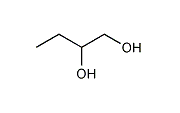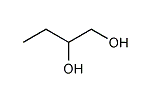1,2-Butylene glycol/1,2-Butanediol12BG/1,2-Butylene glycol/1,2-Butanediol
Mitsubishi Chemical Corporation
12BG (1,2-butanediol) is a branched glycol that has a primary hydroxyl group and a secondary hydroxyl group on adjacent carbon atoms. Mitsubishi Chemical Corporation offers two grades of purity. Both can be reacted with a dicarboxylic acid (e.g., phthalic acid or adipic acid) for use as a polyester polyol or a plasticizer, or reacted with an unsaturated dicarboxylic acid (e.g., maleic anhydride) for use as a raw material for unsaturated polyester resin. The high-purity grade 12BG is suitable for use as a solvent for inks and as a raw material for surfactants.
- EINECS: No. 209-527-2
- Chemical Substance Control Law (CSCL): METI-No. 2-235
- Japan, Industrial Safety and Health Act (ISHA): No. 2-235
- Japan, Poisonous and Deleterious Substances Control Act: Not applicable.
- Japan, Fire Service Act:Hazardous Materials, Category IV—Class III petroleums (water soluble liquids)
Characteristics
[Close]
12BG (1,2-butanediol) is a branched glycol with four carbons that has a primary hydroxyl group and a secondary hydroxyl group.
| Common Names | 1,2-Butanediol 1,2-Butylene Glycol 1,2-Dihydroxybutane |
|---|---|
| Structure |  |
| Functional groups / Classification as compound | Hydroxy group (alcoholic hydroxyl group) |
| Japan, Chemical Substances Control Law METI-No. | 2-235 |
| Japan, Poisonous and Deleterious Substances Control Act | Not applicable |
| Japan, Fire Service Act | Hazardous Materials, Category IV—Class III petroleums water soluble liquids Hazardous Rank III |
| Molecular Weight | 90.1 |
| Appearance | Colorless to pale yellow liquid |
| Odor | Acetic acid smell |
| Specific Gravity (25/4℃) | 1.002 |
| Viscosity(mPa・s) | 38(at 20℃) |
| Boiling Point (℃) | 193 |
| Freezing Point (℃) | -42 |
| Flash Point (℃) | 110 (Cleveland open cup) |
| Autoignition Temperature (℃) | 394 |
| Vapor pressure (kPa) | 0.0027(at 20℃) |
| Heat of Vaporization (kJ/mol) | 61.3 (at boiling point) |
| Heat capacity (kJ/kg・K) | 2.404(at 20℃) |
| Thermal conductivity (W/m・K) | 0.2105(at 20℃) |
Mitsubishi Chemical Corporation started producing both 1,2-butanediol and 1,4-butanediol from butadiene using proprietary technology at its Tokai Plant in 1982.
Applications
[Close]
12BG exhibits excellent characteristics as a solvent for inks and as a raw material for polyester plasticizers (for PVC resins), polyester polyols (soft segment of urethane resins), and unsaturated polyester resins. These versatile products have a very wide range of applications, from general consumer goods, including everyday goods, to durable goods like electronics and automobiles, and even to industrial materials used in machine parts. Their applications are expected to further expand in the future.
Main Applications
- Solvent for inks
Using 12BG as a solvent for inks will greatly enhance the wettability of inks by suppressing the contact angle. Since these inks will also exhibit constant wettability for a variety of substrates, they can be widely utilized as ink solvents for inkjet printers. - Plasticizer for PVC resins
Nonmigratory plasticizers can be made by reacting 12BG with an aliphatic dibasic acid such as adipic acid to form a low-molecular-weight polyester, then esterizing the terminal carboxyl group with an aliphatic alcohol such as hexanol. - Polyester polyol for polyurethane resins
Polyols for urethane resins can be made by reacting 12BG with an aliphatic dibasic acid such as adipic acid or with an aromatic dibasic acid such as phthalic acid to form a low-molecular-weight polyester polyol with a terminal hydroxyl group. Urethane resins made using such polyols exhibit superior physical properties. - Unsaturated polyester resins
Unsaturated polyester resins can be made by reacting 12BG with an unsaturated aliphatic dibasic acid such as maleic acid or its anhydride and with an aromatic dibasic acid such as phthalic acid to form a polyester resin, then dissolving the resin in a polymerizable monomer such as styrene monomer. The ethyl group in 12BG will enhance the solubility into polymerizable monomers, thereby providing ease in handling and allowing the production of resins with excellent water resistance. - Raw material for other polyester resins
12BG can be used as a raw material for resins of adhesives. - Other Applications
12BG can be used as various solvents, coolants, hydraulic oils, surfactants, and fine chemical raw materials.
Storage and Handling
12BG is hygroscopic and susceptible to oxidation. Always use nitrogen dry gas seals to seal storage containers. Store at temperatures not exceeding 40℃.
12BG is a designated hazardous material under the Fire Service Act of Japan and is classified as Category IV—Class III petroleums (water soluble liquids), which corresponds to a Hazardous Rank III substance.
12BG has low volatility and will not self-ignite at room temperature. In the event of fire, effective fire extinguishing agents are powder agents, (alcohol resistant) foam agents, and/or large amounts of water sprayed as mist. 12BG has extremely low toxicity and is a highly safe chemical. When handling, however, wear personal protective equipment such as goggles and protective gloves.
For more information, refer to the Safety Data Sheet (SDS) issued by Mitsubishi Chemical Corporation.
Specifications/Quantities
[Close]
| Item | C12BG | M12BG |
|---|---|---|
| Moisture (%) | ≤ 1 | ≤ 0.5 |
| Purity (%) | ≥ 80 | ≥ 97 |
| Ester (%) | - | ≤ 0.3 |
Ester is present in the form of acetic ester.
Acid Value (mgKOH/g) (reference value) C12BG:Max.1 M12BG:Max.0.1
| C12BG | M12BG | |
|---|---|---|
| Drum | 180kg | 200kg |
| Square oil can | Prepared upon order | 18kg |
Inquiries Concerning Products
View the products of C4 & PBT Dept., Mitsubishi Chemical[Open in a new window]
